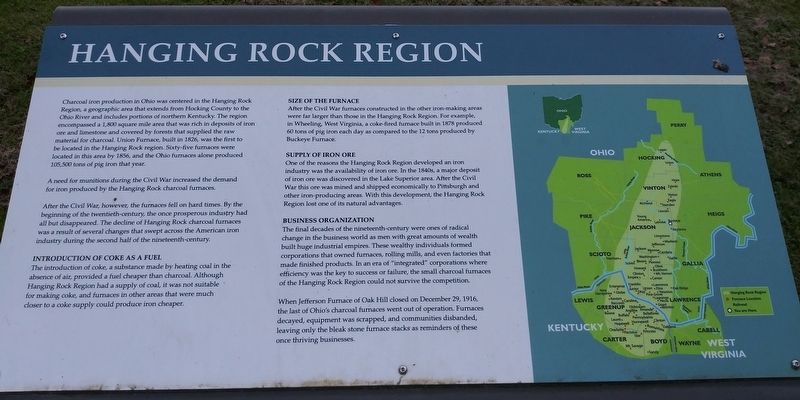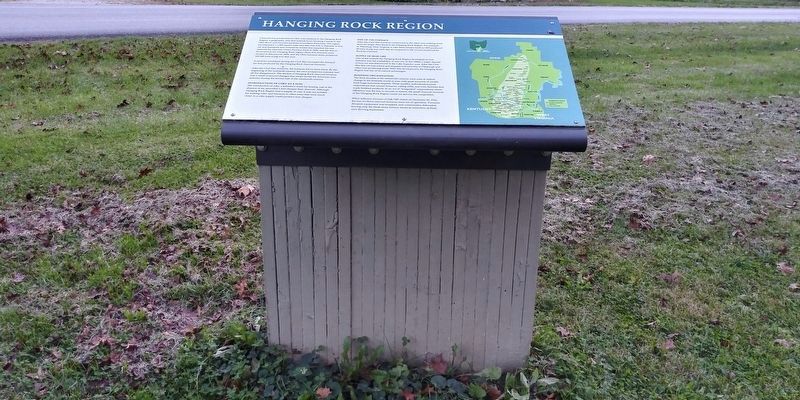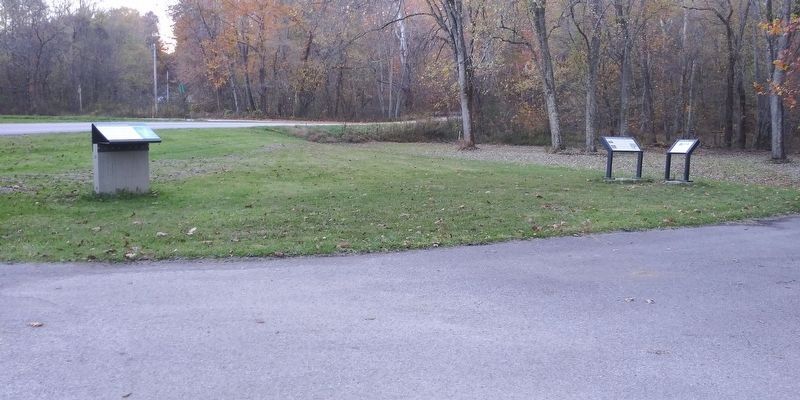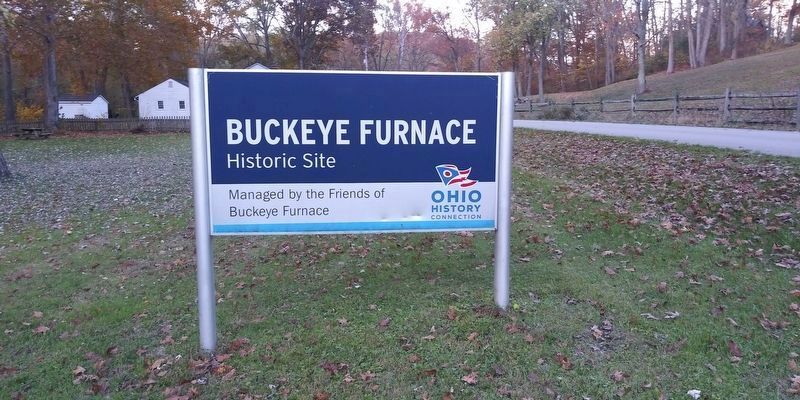Buckeye Furnace in Jackson County, Ohio — The American Midwest (Great Lakes)
Hanging Rock Region
Charcoal iron production in Ohio was centered in the Hanging Rock Region, a geographic area that extends from Hocking County to the Ohio River and includes portions of northern Kentucky. The region encompassed a 1,800 square mile area that was rich in deposits of iron ore and limestone and covered by forests that supplied the raw material for charcoal. Union Furnace, built in 1826, was the first to be located in the Hanging Rock region. Sixty-five furnaces were located in this area by 1856, and the Ohio furnaces alone produced 105,500 tons of pig iron that year.
A need for munitions during the Civil War increased the demand for iron produced by the Hanging Rock charcoal furnaces.
After the Civil War, however, the furnaces fell on hard times. By the beginning of the twentieth-century, the once prosperous industry had all but disappeared. The decline of Hanging Rock charcoal furnaces was a result of several changes that swept across the American iron industry during the second half of the nineteenth-century.
Introduction of Coke as a Fuel
The introduction of coke, a substance made by heating coal in the absence of air, provided a fuel cheaper than charcoal. Although Hanging Rock Region had a supply of coal, it was not suitable for making coke, and furnaces in other areas that were much closer to a coke supply could produce iron cheaper.
Size of the Furnace
After the Civil War furnaces constructed in the other iron-making areas were far larger than those in the Hanging Rock Region. For example, in Wheeling, West Virginia, a coke-fired furnace built in 1878 produced 60 tons of pig iron each day as compared to the 12 tons produced by Buckeye Furnace.
Supply of Iron Ore
One of the reasons the Hanging Rock Region developed an iron industry was the availability of iron ore. In the 1840s, a major deposit of iron ore was discovered in the Lake Superior area. After the Civil War this ore was mined and shipped economically to Pittsburgh and other iron-producing areas. With this development, the Hanging Rock Region lost one of its natural advantages.
Supply of Iron Ore
One of the reasons the Hanging Rock Region developed an iron industry was the availability of iron ore. In the 1840s, a major deposit of iron ore was discovered in the Lake Superior area. After the Civil War this ore was mined and shipped economically to Pittsburgh and other iron-producing areas. With this development, the Hanging Rock Region lost one of its natural advantages.
Business Organization
The final decades of the nineteenth-century were ones of radical change in the business world as men with great amounts of wealth built huge industrial empires. These wealthy individuals formed corporations that owned furnaces, rolling mills, and even factories that made finished products. In an era of "integrated" corporations where efficiency was the key to success or failure, the small charcoal furnaces of the Hanging Rock REgion could not survive the competition.
When Jefferson Furnace of Oak Hill closed on December 29, 1916, the last of Ohio's charcoal furnaces went out of operation. Furnaces decayed, equipment was scrapped, and communities disbanded, leaving only the bleak stone furnace stacks as reminders of these once thriving businesses.
Topics and series. This historical marker is listed in this topic list: Industry & Commerce. In addition, it is included in the Appalachian Iron Furnaces series list. A significant historical date for this entry is December 29, 1916.
Location. 39° 3.297′ N, 82° 27.526′ W. Marker is in Buckeye Furnace, Ohio, in Jackson County. Marker is on Buckeye Park Road (County Road 167) just north of Buckeye Road (County Road 165), on the left when traveling north. Touch for map. Marker is at or near this postal address: 900 Buckeye Park Rd, Wellston OH 45692, United States of America. Touch for directions.
Other nearby markers. At least 8 other markers are within walking distance of this marker. Civil War (here, next to this marker); Buckeye Furnace (1851 - 1894) (within shouting distance of this marker); Scales (within shouting distance of this marker); Furnace Communities (within shouting distance of this marker); Buckeye Furnace Covered Bridge (about 500 feet away, measured in a direct line); Casting (about 600 feet away); Labor At Charcoal Iron Furnace (about 700 feet away); Shipment Of Iron (about 700 feet away). Touch for a list and map of all markers in Buckeye Furnace.
Related marker. Click here for another marker that is related to this marker. This marker has replaced the linked marker.
Credits. This page was last revised on January 28, 2021. It was originally submitted on October 28, 2020, by Craig Doda of Napoleon, Ohio. This page has been viewed 232 times since then and 26 times this year. Photos: 1. submitted on October 28, 2020, by Craig Doda of Napoleon, Ohio. 2, 3, 4. submitted on January 28, 2021, by Craig Doda of Napoleon, Ohio. • Devry Becker Jones was the editor who published this page.



